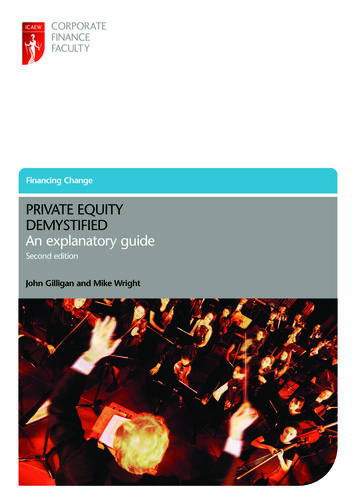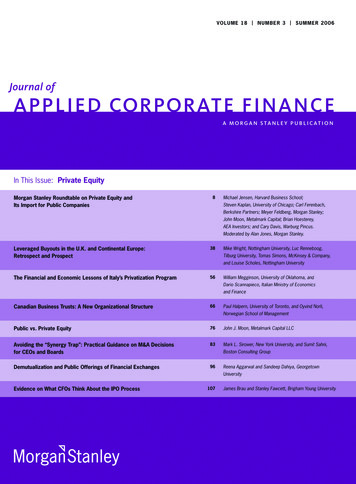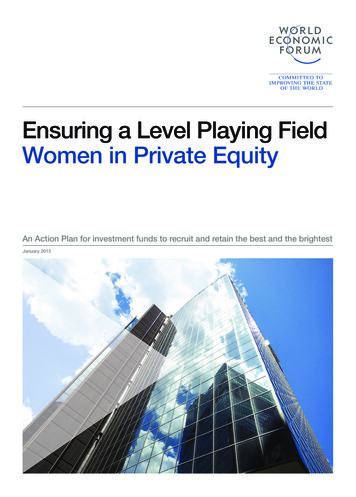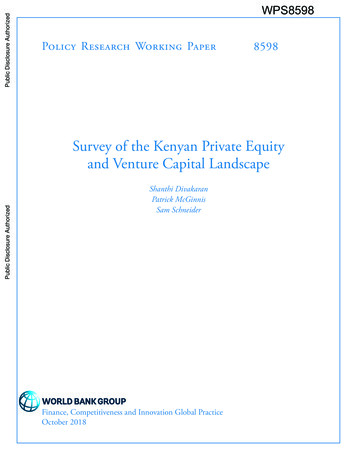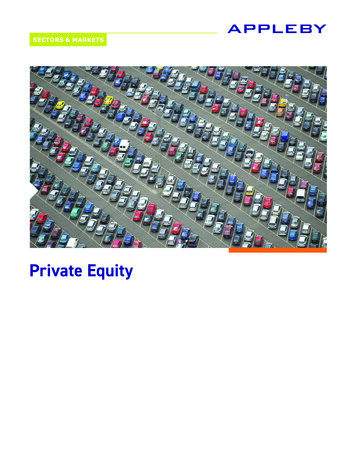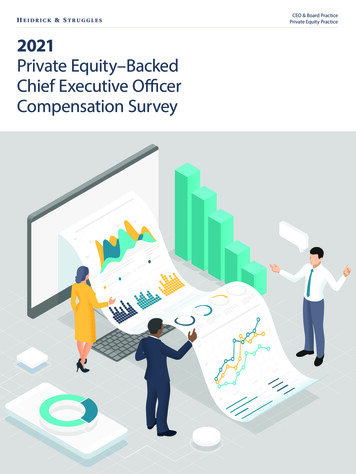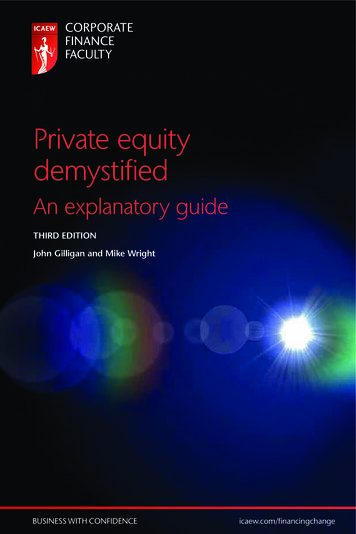
Transcription
Private equitydemystifiedAn explanatory guideTHIRD EDITIONJohn Gilligan and Mike WrightBUSINESS WITH CONFIDENCEicaew.com/financingchange
Private Equity Demystified – An Explanatory GuideAn initiative from the ICAEW Corporate Finance FacultyPrivate Equity Demystified provides an objective explanation of private equity, recognising thatfor public scrutiny of this sector to be effective it must be conducted on an informed basis.This is recognised by the work featuring on reading lists of leading business schools.Since the publication in 2008 of the first edition of Private Equity Demystified the majoreconomies have moved from growth to recession to evidence of emergence from recession.We have seen the enactment and subsequent implementation of the European Commission’sAlternative Investment Fund Managers Directive which covers private equity funds. In addition,the academic world has applied new techniques to old questions as new data sets have becomeavailable. Earlier editions reflected the turmoil of the recession and examined the way in whichthe banking market changed its approach to private equity investments as well as the dynamicsof the restructuring industry.This third edition picks up as many western economies show signs of a resurgence of growth.It examines further developments in private equity, such as its methodologies, management offunds and relationships with limited partners.The value of the work will continue to be measured in better-informed debate, in privateequity’s effective engagement with wider stakeholders, in well thought out public policiesand in awareness among business owners of private equity as a potential source of sustainablefinance for growth.ICAEW Corporate Finance FacultyThe Corporate Finance Faculty’s professional network includes 6,000 members and more than70 member organisations.Its membership is drawn from major professional services groups, specialist advisory firms,companies, banks, private equity, venture capital, law firms, brokers, consultants, policymakersand academic experts. More than 40% of the faculty’s membership is from beyond ICAEW.The faculty is ICAEW’s centre of professional excellence in corporate finance. It contributesto policy development and many consultations by international organisations, governments,regulators and other professional bodies. The faculty provides a wide range of services, eventsand media to its members, including its magazine Corporate Financier.The faculty initiated the development of the first international Corporate Finance qualification(including the ‘CF’ designation) for practitioners and launched a Diploma in Corporate Financewith the CISI in 2012.Private Equity Demystified is issued under Financing Change, the thought leadership programmeof the faculty. Financing Change aims to advance the economic and social contribution ofcorporate finance activity by promoting better understanding and practice.For further information on the Financing Change programme or to send views and othercomments on this work and related themes, please email financingchange@icaew.com ortelephone 44 (0)20 7920 8685.For information on ICAEW’s work in funding academic research please contact Gillian Knight,Research Manager on 44 (0)20 7920 8478.This work, which includes a summary of academic studies and references, is also available todownload from icaew.com/cff. John Gilligan and Mike Wright 2014 ICAEW design and typographical layout 2014All rights reserved. If you want to reproduce or redistribute any of the material in thispublication, you should first get ICAEW’s permission in writing. ICAEW will not beliable for any reliance you place on the information in this publication. You should seekindependent advice.ISBN 978-1-78363-168-1
Private equitydemystifiedAn explanatory guideTHIRD EDITIONJohn Gilligan and Mike Wright
ContentsPagePreface to the third edition07Acknowledgements08About the authors09List of figures and tables101. THE PRIVATE EQUITY MARKET131.1 What is private equity?141.1.1What is a private equity fund?141.1.2What are the objectives of private equity investment?141.1.3What is the difference between venture capital, growthcapital and private equity?1.1.414Are there any theoretical ideas behind the private equityinvestment model?151.1.5What do private equity fund managers do?161.1.6What risks do investors in private equity funds take?171.1.7What risks do private equity fund managers take themselves?171.1.8What rewards do private equity investors earn?181.1.9What is carried interest?1.1.10 What is leverage and what role does it play in private equity?18181.1.11 What impact does the gearing have on the private equity fundmanager’s return?201.1.12 Does size matter?201.1.13 What impact does leverage have on bankruptcy risk?211.1.14 How do private equity funds control their investments?211.1.15 Leverage in funds versus leverage in investments211.1.16 What market risks does private equity create?221.1.17 A financial canary in the coal mine?221.2 A summary of the core ideas. The 4As: amplification, alignment, activemanagement and attention to detail1.3 A brief history of private equity22231.3.1Asset stripping and financial assistance231.3.21980s first buy-out boom231.3.31980s ‘hand-off, eyes-on’241.3.4Mid-1980s: new entrants241.3.51989: mega deals V1.024Private Equity Demystified: An explanatory guide01
1.3.6Captives versus independents241.3.7Yield versus capital gain241.3.81990s blow up and buy-outs of captive funds241.3.9Hands-on investors and sector specialisation251.3.10 Globalisation and the growth of global mega-funds251.3.11 2005–2007: boom251.3.12 2007–2008: bust261.3.13 2009–2012: hangover261.3.14 2014: where we are today261.4 How big is the private equity market?271.4.1How significant are larger deals in the private equity market?291.4.2The death of the management buy-out?301.4.3The company auction process311.4.4Deal initiation and proprietary deal flow321.4.5What have been the biggest UK deals?321.4.6What have been the biggest deals in the world?331.4.7What are the largest private equity funds in the world?341.4.8How significant are public to private transactions in the privateequity market352. PRIVATE EQUITY FUNDS, FUNDERS AND OTHER MARKET PARTICIPANTS2.1 The private equity fund37382.1.1What is a private equity fund?382.1.2How are private equity funds structured? ‘Ten plus two’ funds382.1.3Why are private equity funds partnerships?382.1.4What are LPs and GPs?392.1.5Who are the investors in private equity funds?392.1.6What are sovereign wealth funds?412.1.7How are private equity fund managers rewarded?412.1.8Other fees432.1.9What is co-investment and how does it differ from carried interest? 432.1.10 What are separate managed account arrangements?442.1.11 How does a private equity fund differ from a quoted equity fund? 442.1.12 How does a private equity fund differ from a group of companies? 462.1.13 What are hedge funds and how do they differ from private equityfunds?482.1.14 Emerging and converging alternative asset investors502.1.15 Can a private equity fund or private equity manager fail?512.1.16 Where do private equity fund managers operate?522.1.17 Why have European private equity funds been basedpredominantly in the UK?02532.1.18 Fund raising and investors in private equity funds542.1.19 Committed versus invested capital552.1.20 Investor cash flows: the J curve (at cost)56Private Equity Demystified: An explanatory guide
2.1.21 Fund management fees572.1.22 Fund extensions572.1.23 Competition for funds by private equity managers572.1.24 What are founders’ rights and re-ups?582.1.25 What is ‘most favoured nation’ status?582.1.26 First closes, early commitment discounts and speed of fund-raising 582.1.27 How can individual investors invest in private equity funds?582.1.28 What is the secondary fund market?592.1.29 Why do private equity funds value unrealised investments?602.1.30 How do private equity funds value unrealised investments?612.1.31 Understanding private equity portfolio valuation movements622.1.32 Valuation of limited partner holdings: the J curve revisited632.1.33 What are DPI and TVPI as measures of return?642.1.34 What is the range of returns for investors?642.1.35 Banks and other lenders672.1.36 What are collateralised debt obligations, collateralised loanobligations and structured investment vehicles?2.1.37 Non-bank lenders2.2 Advisers and other service providers7073732.2.1Who provides outsourced services?732.2.2Who are transactions advisers?732.2.3Who are fund-raising advisers?742.3 Employees and other stakeholders2.3.12.3.275What is the impact of private equity transactions on widerstakeholders?75What is TUPE and when is it applied?752.4 Taxation782.4.1Investors in a private equity fund782.4.2Private equity executives/fund792.4.3Investee companies812.5 Refinancing and exits832.5.1Types of exit832.5.2What has been the pattern of exits from private equity deals?842.5.3Secondary buy-outs and new principal agent issues842.5.4What is a leveraged recapitalisation?872.5.5What is a secondary fund market transaction andhow does it differ from a secondary buy-out?872.6 How did the UK private equity industry respond to public scrutiny?912.6.1What are the Walker Guidelines?922.7 What is the Alternative Investment Fund Managers’ (AIFM) Directiveand what are its implications for private equity?Private Equity Demystified: an explanatory guide9303
3. EVALUATING, STRUCTURING AND RESTRUCTURING A PRIVATE EQUITYINVESTMENT953.1 Who’s who in a private equity transaction963.1.1What is the role of the wider stakeholder?973.1.2Value and pricing97993.1.3Net present value, IRR and theoretical valuation methods3.1.4What is ‘financial engineering’?3.1.5How do you design and build financial instruments?1003.1.6What is a ‘Newco’?1033.1.7How do you decide whether to buy shares or assets?1033.1.8Pricing a transaction1043.1.9A financeable offer1043.2 Senior debt and mezzanine104993.2.1What is debt?10 3.2.2How much debt?1053.2.3How did banks increase the levels of borrowing in buy-outs?Capital holidays and bullet loans3.2.4108How did banks increase the levels of borrowings in buy-outs?Payment-in-kind debt1093.2.5Why did banks increase the amount of debt?1093.2.6What is mezzanine?1103.2.7Can Newco repay the borrowings?1123.2.8What security will the banks have?1123.2.9What are the potential sources of cash flow to repay borrowings? 1133.2.10 Increasing post-tax profits1133.2.11 Reducing working capital1143.2.12 Fixed assets: to own or lease?1143.2.13 What are propco/opco structures? A special case1143.2.14 Asset stripping and financial assistance1183.2.15 What protection exists for publicly quoted companies?1183.2.16 The risks of leverage: financial covenants and events of default1193.2.17 Incurrence covenants and maintenance covenants1193.2.18 An event of default and corporate failure1203.2.19 How can the risks of leverage be mitigated?1203.2.20 Has anything changed since the banking crisis?1213.2.21 Restoring leverage: asset-based lenders1223.2.22 Alternative debt providers and unitranche debt1223.3 Institutional and management equity041233.3.1How much institutional equity?3.3.2Debt:equity ratio1231263.3.3Did the largest leveraged buy-outs fail during the recession?1273.3.4How much equity do management get in a buy-out?1283.3.5What is a ratchet?128Private Equity Demystified: an explanatory guide
3.4 Distress and restructuring1293.4.1What are the types of company distress?1293.4.2What is equity cure?1303.4.3What is financial restructuring?1303.4.4What is a ‘hair cut’ and who bears it?1313.4.5What powers does a secured lender have?1323.4.6What tools are available to restructure a balance sheet?1333.4.7Summary1343.4.8What are the differences in restructuring publicly traded debt?1343.4.9Equity investors: the impact of distress1353.4.10 Equity investors: what are the options?1363.4.11 What is the position of management in a restructuring?1373.4.12 What is a good leaver/bad leaver?1374. A WORKED EXAMPLE4.1 A detailed worked example of a leveraged buy-out1391404.1.1Operating profit projections1404.1.2A note on valuations1414.1.3Cash flow projections1414.1.4A profit bridge1424.1.5Funding requirement1444.1.6What are the transaction fees and expenses?1444.1.7What are contingent fee arrangements?1454.1.8A funding structure1454.2 The impact of leverage on profits and cash1484.3 Restructured balance sheet1534.4 PIK loanstock: what is the ‘equity illusion’?1544.5 Taxation: how much tax is paid by a private equity-backed company?1554.6 Summary of company corporation tax1574.7 What is investment due diligence?1584.8 What is vendor due diligence and how does it impact risks/rewards?1584.9 Sensitivity analysis1594.10 Exits and returns1594.11 Closing remarks1635. CRITICS AND THE RESEARCH1655.1 Is private equity about majority acquisitions of large listed corporations?1665.2 Does private equity create systemic risk?1665.3 What happened to the ‘wall of debt’?1665.4 Is there excessive debt and are gains from leverage?1665.5 Does the industry suffer from short-termism and do private equitybuy-outs result in underinvestment?1675.6 Is there a lack of employee consultation in private equity-owned firms?1685.7 Is there tax avoidance and why are tax havens used?169Private Equity Demystified: an explanatory guide05
5.8 Is there a culture of secrecy?1695.9 Is there overpayment of executives?1695.10 Is there sufficient permanent capital in private equity funds?1705.11 Is there a misalignment of incentives?1705.11.1 Fund level fees1705.11.2 Transaction fees1705.11.3 Zombie funds1715.11.4 Late fund stuffing1715.11.5 Equity illusion1715.11.6 Time value of money1715.11.7 Funding acquisitions1715.11.8 Credit default swaps1715.11.9 Valuation of unrealised investments1715.12 Do the conclusions to be reached about private equity dependon the evidence base?1725.13 What are the areas for further research?172APPENDIX: SUMMARIES OF STUDIES OF BUY-OUTS AND PRIVATE EQUITY175REFERENCES199GLOSSARY21006Private Equity Demystified: an explanatory guide
Preface to the third editionFor over two decades, from the early 1980s, the developing private equity industrylargely flew below the radar of public scrutiny. In 2007 the private equity industry cameunder intense public scrutiny including a House of Commons Select Committee enquiry.We published the first edition of Private Equity Demystified in August 2008. There followeda period of unprecedented financial turmoil. The second edition built on the first editionto reflect the effects of the recession and examined the way in which the banking marketchanged its approach to private equity investments. It also included more discussion ofboth mid-market buy-outs and the dynamics of the restructuring industry. There was anupdate to the second edition in 2012 to reflect the developments in private equity as therecession came to an end. This third edition examines further developments in privateequity, as many western economies again experience economic growth. The EuropeanCommission’s Alternative Investment Fund Managers Directive which covers privateequity funds is also being implemented. A burgeoning body of academic evidence alsocontinues to provide systematic insights as to the impact of private equity.In this third edition we have taken the opportunity to make a thorough revision of earliereditions. Two major innovations are particularly notable.First, as the industry has become increasingly international we have extended thecoverage of the trends in private equity beyond the UK;Second, as the economy and the industry emerge from recession, we have developeda new section revisiting the accusations laid at the feet of private equity by its critics atthe height of the last boom in 2007. Drawing on the increasing evidence now available,we show that many of the criticisms of private equity were misplaced. We argue thatin contrast to the forecasts of the critics, private equity has acted to contain risk, notdisseminate it; has created alignment between managers and shareholders, not amisaligned bonus culture; and provides important models for corporate governance andrisk management that have a wider applicability.Nevertheless, some challenges remain regarding the relationships between privateequity firms and their investors, notably regarding fees and the valuation of unrealisedinvestments.John GilliganMike WrightNovember 2014Private Equity Demystified: an explanatory guide07
AcknowledgementsThis report has benefited immeasurably from the support and positive criticism of anumber of people, including anonymous reviewers and colleagues within both BDOand The Centre for Management Buy-out Research at Imperial College.Chris Ward, Chairman of the ICAEW Corporate Finance Faculty from 2004 to 2008, notonly saw the need for a report, but tirelessly reviewed many drafts with an eye for bothdetail and the big picture second to none, giving far more of his time than we couldhave expected and he could have anticipated when we first started.Jon Moulton, Chairman, Better Capital; Maggie Rodriguez-Piza, Chief Executive, FundingLondon; and Mark Pacitti, Partner, Deloitte, provided helpful comments on early drafts.Mark O’Hare and Chris Elvin of Preqin provided data on international dimensions ofprivate equity.Adam Frais of BDO contributed the sections on taxation aspects.Without David Petrie, Shaun Beaney and especially Katerina Joannou of ICAEW the reportwould never have seen the light of day. Thanks also to Debbie Homersham of ICAEWand Nick Toyas of ToyasOmara.All errors and omissions are entirely our own responsibility.In the absence of any tangible reward we offer our sincere thanks to all of these people.08Private Equity Demystified: an explanatory guide
About the authorsJohn Gilligan is a Corporate Finance Partner in BDO LLP. He has worked in the privateequity and venture capital industry for over 25 years. He started his career in 1988 at3i Group plc as a financial analyst. Prior to BDO he was a partner of Deloitte. He is anon-executive director of Big Issue Investment Fund Management, one of the largestsocial impact investors in the UK. He has a degree in economics from SouthamptonUniversity and an MBA in financial studies from Nottingham University.Professor Mike Wright is Professor of Entrepreneurship and Head of the Innovation andEntrepreneurship Department at Imperial College Business School. He is Director of TheCentre for Management Buy-out Research which he founded in 1986 and has beenAssociate Director of the Enterprise Research Centre since 2013. He has written over 50books and more than 400 papers in academic and professional journals on managementbuy-outs, venture capital, habitual entrepreneurs, corporate governance and relatedtopics. He served two terms as an editor of Entrepreneurship Theory and Practice(1994 1999) and of the Journal of Management Studies (2003 2009) and is currentlya co-editor of Strategic Entrepreneurship Journal. He holds a BA (CNAA), MA (Durham),PhD (Nottingham) and honorary doctorates from the Universities of Ghent and Derby.He was the winner of the Academy of Management Entrepreneurship Division MentorAward in 2009 and was chair of the Division in 2011/12. He is also an Academician ofthe Academy of Social Sciences.Contact detailsJohn GilliganPartner Corporate FinanceBDO LLP55 Baker StreetLondon W1U 7EUUKEmail: john.gilligan@bdo.co.ukMike WrightThe Centre for Management Buy-out ResearchImperial College Business School46 Exhibition RoadLondon SW7 2AZUKEmail: mike.wright@imperial.ac.ukandDepartment of Management, Innovation and EntrepreneurshipUniversity of GhentTweekerkenstraat 29000 GhentBelgiumPrivate Equity Demystified: an explanatory guide09
List of figures and tables1. THE PRIVATE EQUITY MARKETFigure 1.1: Effects of leverage – no debt18Figure 1.2: Effects of leverage – 50% debt19Figure 1.3: Effects of leverage – 90% debt19Figure 1.4: Effects of leverage – 50% debt: 50% repaid20Figure 1.5: Global private equity investments27Figure 1.6: Global private equity funds raised ( bn) 1984–201428 m) 1985–2013Figure 1.7: Value of European buy-outs (C28Figure 1.8: European buy-out market by number of transactions 1985–201329Figure 1.9: 100m buy-outs as a percentage of the market by number and value (UK) 1985–2013 30Figure 1.10: Buy-in versus buy-out by number (Europe) 1985–201330Figure 1.11: Buy-in versus buy-out by value (Europe) 1995–201331Figure 1.12: Percentage share of public to private buy-outs by number and value (UK) 2004–2013 35Table 1.1:Selected large UK buy-out firms and their predecessors25Table 1.2:Largest UK buy-outs to date32Table 1.3:The world’s largest buy-outs33Table 1.4:Estimate of the world’s largest private equity funds (all time)342. PRIVATE EQUITY FUNDS, FUNDERS AND OTHER MARKET PARTICIPANTSFigure 2.1: Structure of a typical private equity fundFigure 2.2: Investors in private equityFigure 2.3: Geographic origin and country of management of European funds raised in 2013Figure 2.4: The relationship between costs and incomeFigure 2.5: The mechanics of carried interestFigure 2.6: Forms of diversification undertaken by world’s largest private equity managersFigure 2.7: Investment bn by country January 2006–July 2014(exc. US; countries with at least 5bn invested)Figure 2.8: Private equity investment cycleFigure 2.9: Illustrative investor cash flowsFigure 2.10: Illustrative fund management fees over timeFigure 2.11: Percentage of value realised and not realised by vintage of fundsFigure 2.12: Illustrative equity valuation bridgeFigure 2.13: Value per invested in UK private equity firms: distributed and undistributed valueby fund vintage as at 31 December 2013Figure 2.14: Distribution of returns to mid–large buy-out funds by vintage of fund– total value per invested (funds over six years old)Figure 2.15: Distribution of returns to private equity funds by vintage of fund– cash distributed per invested (funds over six years old)Figure 2.16: Schematic of a CDO/CLO/SIVFigure 2.17: Flow of risks from original lenders through securitisation to bond marketsFigure 2.18: Illustrative advisers to a transactionFigure 2.19: Detailed structures in a typical private equity fundFigure 2.20: Different common buy-out structuresFigure 2.21: European divestment numbers by type of ivate Equity Demystified: an explanatory guide
Figure 2.22:Figure 2.23:Figure 2.24:Figure 2.25:Table 2.1:Table 2.2:Table 2.3:Table 2.4:Table 2.5:European primary and secondary buy-outs by numberEuropean primary and secondary buy-outs by valueTypical simplified fund structure to illustrate different secondary transactionsAverage time to exit in private equity-backed buy-outs by year of exit in the UKTop 20 fund-of-funds investors in global private equity 2013Key differences between private equity and quoted equity fundsKey differences between private equity and trading groups of companiesKey differences between private equity and hedge fundsPrivate equity and portfolio firm compliance with the Walker Guidelines3. EVALUATING, STRUCTURING AND RESTRUCTURING A PRIVATE EQUITY INVESTMENTFigure 3.1: Participants in a leveraged buy-outFigure 3.2: Equity value, enterprise value and asset valueFigure 3.3: Types of financial instrument: risk and rewardFigure 3.4: The basic building blocks of financial engineeringFigure 3.5: Outline structure of a leveraged buy-outFigure 3.6: Relationship between length of loan, interest rate and multiple of free cash flowFigure 3.7: Illustrative security value of a failing company’s assetsFigure 3.8: Impact of capital holidays of various lengths on the cash requirement of loans(seven-year loans)Figure 3.9: Percentage of UK buy-outs ending in receivership/administration by vintage yearFigure 3.10: Structural subordinationFigure 3.11: Illustration of the restructuring into a propco/opco structureFigure 3.12: Schematic illustrating banking covenantsFigure 3.13: IRR versus time of exit at various exit multiplesFigure 3.14: European deal structures (deals 100m or more, %)Figure 3.15: The limits of the most common restructuring optionsTable 3.1:Calculation of enterprise value and equity valueTable 3.2:Pricing ratiosTable 3.3:Creating a hierarchy of financial instruments by varying risk and rewardTable 3.4:Stylised comparison of security in a retailer and a manufacturerTable 3.5:IRRs calculated at varying exit years and varying exit multiples of original investmentTable 3.6:Multiple of money calculated at varying years of exit and IRRsTable 3.7:Impact of varying yields on the capital gain required to generate an IRR of 25%Table 3.8:Largest private equity-backed receiverships4. A WORKED EXAMPLEFigure 4.1: Actual and forecast sales and profitFigure 4.2: EBITDA and operating cash flowsFigure 4.3: EBIT: profit bridgeFigure 4.4: Sources of fundsFigure 4.5: The funding package is analysed by funding requirement, security available,source of funds, detailed financial instrument and type of financial instrumentFigure 4.6: Profit: EBITA, EBIT, NPBTFigure 4.7: Difference between interest accrued and interest paidFigure 4.8: Cash flows – before and after finance costsFigure 4.9: Forecast values of interest cover and cash coverFigure 4.10: Forecast security coverFigure 4.11: Taxable profit and accounting profit are differentFigure 4.12: The book value of assets is different to the tax written down value becauseof accelerated capital allowancesFigure 4.13: Representation of goodwillPrivate Equity Demystified: an explanatory 14614914915015215215515615711
Table 4.1:Table 4.2:Table 4.3:Table 4.4:Table 4.5:Table 4.6:Table 4.7:Table 4.8:Table 4.9:Table 4.10:Table 4.11:Table 4.12:Table 4.13:Table 4.14:Table 4.15:Table 4.16:Table 4.17:Table 4.18:Table 4.19:Table 4.20:Table 4.21:Operating profit projectionsActual and forecast operating cash flowsEBIT: profit bridgesFunding requirementSources of fundingIllustrative financing structureSummary of projected profit and loss after fundingReconciliation of projected interest chargesSummary of cash flows after fundingSummary of projected balance sheetsAlternative balance sheet presentationPIK debt and the equity illusionRestatement of profit for tax purposesCalculation of goodwillEnterprise value and equity value at exitAllocation of net equity valueProjected share of exit enterprise value by investorReconciliation of the cumulative effects of operating performance and financialengineering on projected equity value at exit in years 2 and 3Split of proceeds on exitProjected returns (IRRs) by participant (exit year 3, P/E 12)Private equity investor blended returns – sensitised by year of exit and exit P/E ratio5. CRITICS AND THE RESEARCHFigure 5.1: Buy-out types, strategy and 157160160161161162162163168Private Equity Demystified: an explanatory guide
1. The private equity marketIn this section we set the scene: we clarify some definitions,describe the origins of the private equity market and examinethe data on the size and growth of the private equity industry.
1.1 What is private equity?‘Private’Private equity is risk capital provided outside the public markets. It is worth emphasisingat this early stage that the word ‘private’ has nothing to do with secrecy. It simplycontrasts with the ‘public’ quoted markets.‘Equity’Equity is the umbrella term under which you find an array of financial instruments thatequitably share in the profits and losses of a business. Traditionally equity was seen asbeing synonymous with ‘ordinary shares’. It is still the convention to refer to an equitypercentage meaning the percentage of ordinary shares held. However, as we will expandupon, equity has a broader meaning when used in the phrase ‘private equity’. It meansthe total amount of capital that is both put at risk of loss in a transaction and that, as afinancial package, has a share in any capital gain earned. As we elaborate in sections 3 and4, a private equity investment will often be in the form of both ordinary shares and loans.1.1.1 What is a private equity fund?Much, but not all, of the investing done in the private equity market is by private equityfunds. A private equity fund is a form of ‘investment club’ in which the principal investorsare institutional investors such as pension funds, investment funds, endowment funds,insurance companies, banks, family offices/high net worth individuals and funds-offunds, as well as the private equity fund managers themselves. The objective of a privateequity fund is to invest equity or risk capital in a portfolio of private companies which areidentified and researched by the private equity fund managers. Private equity funds aregenerally designed to generate capital profits from the sale of investments rather thanincome from dividends, fees and interest payments.A private equity fund may take minority or majority stakes in its investments, thoughgenerally it will be the latter in the larger buy-outs. At the same time that a privateequity fund makes an investment in a private company, there is usually some bank debtor other debt capital raised to meet part of the capital required to fund the acquisition.This debt is the ‘leverage’ of a leveraged buy-out.1.1.2 What are the objectives of private equity investment?Obviously all investors wish to make a return. This can be either an income, from interestor dividends, or a capital gain by selling a particular investment when it has been mademore valuable. Private equity is predominantly about generating capital gains. The idea isto buy equity stakes in businesses, actively managing those businesses and then realisingthe value created by selling or floating the business. The appetite and incentives of mostprivate equity investors are firmly focused on achieving capital gains. They
2.1.29 Why do private equity funds value unrealised investments? 60 2.1.30 How do private equity funds value unrealised investments? 61 2.1.31 Understanding private equity portfolio valuation movements 62 2.1.32 Valua tion of limited partner holdings: the J curve revisited 63 2.1.33 What are DPI and TVPI as measures of return? 64





